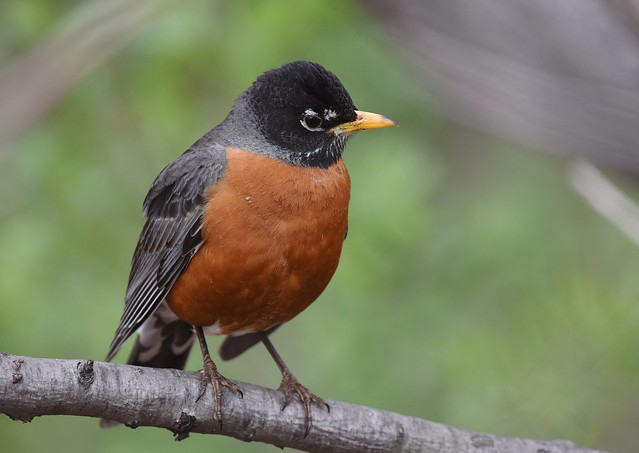BY KIERAN LINDSEY, PhD
Walking with my terrier-boy in Lafayette Park, I often happen upon the beginning of a late-afternoon performance by the American Robin Ballet Company. The dancers scatter across the lawn, their dark charcoal cloaks and garnet waistcoats vivid against a verdant stage. They appeared frozen in place, waiting for the orchestra’s opening chords. Then all at once they began to move, not in sync but all using the same choreography…
Step… step… step… a brief, brisk run… then plié… relevé… repeat.
Adagio (step… step… step)… allegro (step,step,step)… plié… relevé… repeat.

 If you think about it, there’s nothing more natural than to imagine robins and other songbirds as dancers. For one thing, they’re nearly always on at least demi pointe—what you and I might call our tiptoes. What we think of as the bird’s foot is actually just the digits, and what we would identify as the knee is actually the ankle… the knee is tucked up close to the belly and sides.
If you think about it, there’s nothing more natural than to imagine robins and other songbirds as dancers. For one thing, they’re nearly always on at least demi pointe—what you and I might call our tiptoes. What we think of as the bird’s foot is actually just the digits, and what we would identify as the knee is actually the ankle… the knee is tucked up close to the belly and sides.
 For the corps de ballet in this show, function is as important as form; this dance is a literal hunt, a stylish, graceful way to pick up some dinner.
For the corps de ballet in this show, function is as important as form; this dance is a literal hunt, a stylish, graceful way to pick up some dinner.
The appearance of robins is considered by many to signal the arrival of spring; however, in many parts of North America, including St. Louis, robins are year-round residents. In winter they form large nighttime roosts that may consist of well over a hundred thousand individual birds. There is strength—and warmth—in numbers.
In spring and summer, after pairs have formed for pas de deux, males and females both contribute to the care and feeding of their offspring. During the day, that is. A night, females sleep on the nest, warming eggs or nestlings, but the males continue to gather each evening to sleep at the communal roost. As young robins gain their independence they’ll leave the nest and join the males at night.



 another series of steps, the audience may assume the bird is listening intently. But ornithologists believe robins are actually looking for signs of digging that reveal the location of an earthworm. They—the birds, not the ornithologists (well, maybe some of the ornithologists)—consume other invertebrates, too, including snails and insects, along with a variety of wild fruits. It’s exactly the kind of high-protein, high-fiber, low-fat diet dancers need to remain light on their feet.
another series of steps, the audience may assume the bird is listening intently. But ornithologists believe robins are actually looking for signs of digging that reveal the location of an earthworm. They—the birds, not the ornithologists (well, maybe some of the ornithologists)—consume other invertebrates, too, including snails and insects, along with a variety of wild fruits. It’s exactly the kind of high-protein, high-fiber, low-fat diet dancers need to remain light on their feet.